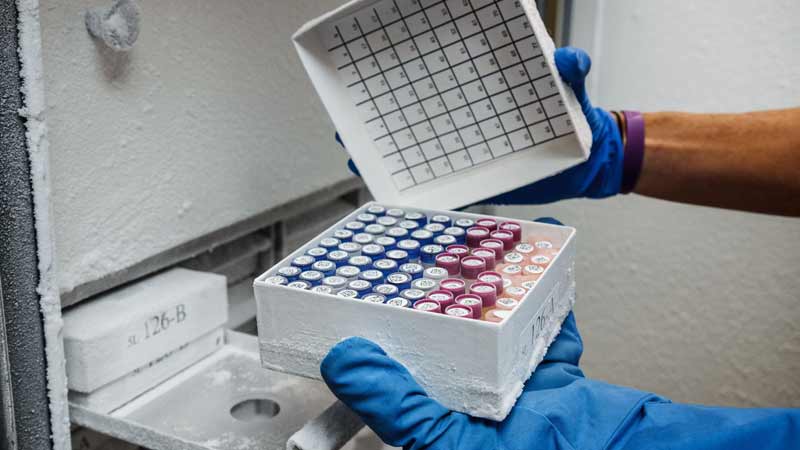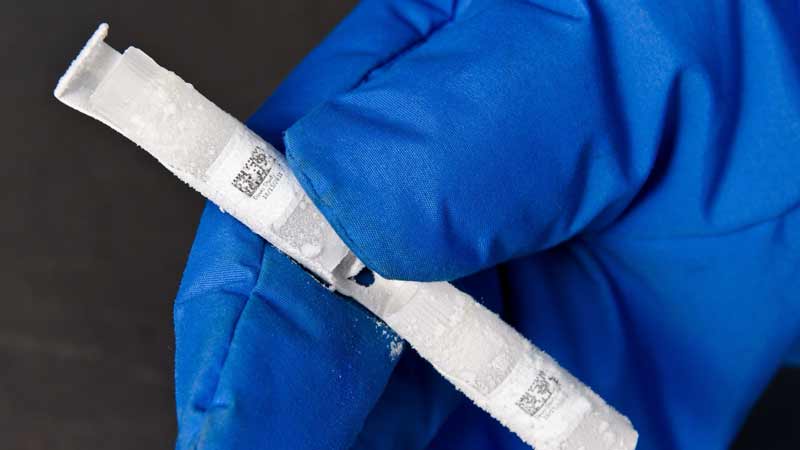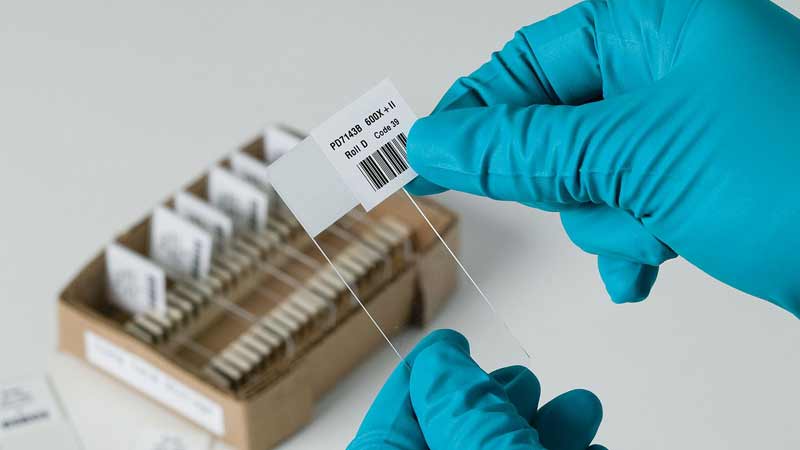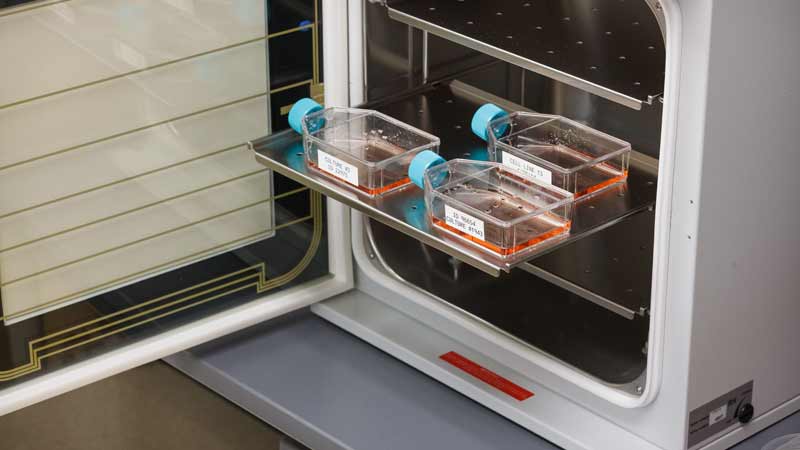In demanding lab environments, label durability is critical. This guide provides a comprehensive overview of four types of durable lab labels offered by Brady: cryogenic labels, chemical-resistant labels, heat-resistant labels and moisture-resistant labels.
By understanding the benefits and applications of label durability, researchers and lab professionals can select the most suitable labels for their specific needs, ensuring accurate identification and safety in even the most challenging laboratory conditions.
Cryogenic labels
Cryogenic labels are designed to withstand extreme cold temperatures and typically found in cryogenic storage environments such as liquid nitrogen tanks or freezers. They’re commonly used in labs and research facilities for identifying and tracking lab samples, specimens and other materials stored in cryogenic conditions.
Materials and Construction
The materials and construction of cryogenic labels play a critical role in their ability to withstand harsh environments and maintain their integrity. Here are the key materials and construction features:
Materials:
- Base material: The base is typically made from durable materials like polyester or polypropylene, which are resistant to chemical abrasion and can endure the extreme cold of cryogenic storage.
- Adhesive: Special adhesives are engineered to adhere to curved or flat surfaces and maintain their bond at extremely low temperatures.
Construction:
- Multi-layer construction: Cryogenic labels may consist of multiple layers, with each layer providing a specific function. For example, the top layer may be made of a chemical-resistant material, while the bottom layer may be made of a pressure-sensitive adhesive.
- Laminated construction: Some cryogenic labels are laminated with a protective layer to enhance their resistance to abrasion, chemicals, and moisture.
- Reinforced edges: The edges of the labels may be reinforced to prevent peeling or tearing.
The combination of durable materials and carefully engineered construction ensures that cryogenic labels can withstand the extreme cold of cryogenic storage environments.
Resistance to extreme temperatures
These labels are used in storage environments such as liquid nitrogen tanks or freezers, where temperatures can reach as low as -320°F. This resistance to extreme temperatures is important for many reasons:
- Sample integrity: To ensure the integrity and viability of specimens and biological samples, it’s crucial that labels remain intact and legible at extremely low temperatures.
- Accurate identification: Cryogenic labels can prevent errors and ensure the validity of research results, even after long-term cryogenic storage.
- Safety and compliance: Cryogenic labels help to ensure compliance with strict regulations and safety protocols by providing a reliable means of identifying and tracking samples in cryogenic storage.
- Long-term storage: Cryogenic storage can be used for long-term preservation of biological samples, specimens and other materials without compromising integrity.
Applications
Cryogenic labels are commonly used in various lab applications, including:
- Biobanking and sample storage: Identifying and tracking biological samples, specimens and cell cultures stored in cryogenic biorepositories
- Pharmaceutical research and development: Labeling cryogenic vials and tubes containing drugs, vaccines and other pharmaceutical substances
- Medical and clinical laboratories: Identifying patient samples, tissues and other specimens stored in cryogenic freezers
- Cryogenic shipping and transport: Labeling cryogenic containers and packages for safe and secure transport of temperature-sensitive materials
Chemical-resistant labels
Purposes and uses
Chemical-resistant labels are designed to withstand exposure to harsh chemicals, solvents, acids and bases. They’re commonly used in lab and industrial settings where chemicals are handled or stored.
Materials and construction
Chemical-resistant labels are typically made from durable materials — like polyester, polyethylene or vinyl — that are specifically chosen for their resistance to harsh chemicals. Their construction also plays a crucial role in their durability, and is similar to cryogenic labels in that many feature multiple layers, lamination and reinforced edges.
Resistance to solvents, acids and bases
Without chemical-resistant labels, not only would it be difficult to identify hazardous chemicals, but there would be no way to ensure the integrity of the chemicals themselves. Harsh abrasives can degrade or contaminate labels that aren’t resistant, leading to errors.
These are the main substances that necessitate chemical resistance:
- Chemicals: Overall, these labels are inherently resistant to a wide range of chemicals so they can’t be easily broken down or dissolved
- Solvents: Solvents are often used in lab and industrial settings so it’s important that the labels maintain their adhesion and legibility even when exposed
- Acids: Acids can be highly corrosive, but these labels can withstand exposure to acids without significant damage or deterioration
- Bases: Bases can also be corrosive and alkaline so the labels need to maintain their integrity when exposed
Applications
The resistance to solvents, acids and bases makes these labels ideal for demanding environments where chemicals are handled or stored. In lab settings, two common applications are:
- Laboratory labeling:
- Labeling chemical containers, bottles, and vials
- Identifying hazardous substances
- Tracking chemical inventory
- Labeling laboratory equipment and instruments
- Safety precautions and warnings
- Medical and pharmaceutical labeling:
- Labeling medical and pharmaceutical products
- Identifying active ingredients and dosages
- Safety precautions and warnings
- Labeling medical devices and equipment
Heat-resistant labels
Purposes and uses
Heat-resistant labels are designed to withstand high temperatures and are commonly used in lab environments where heat exposure is a concern.
Materials and construction
The materials used in heat-resistant labels are carefully selected to provide exceptional thermal stability. They are typically made from high-performance materials and can withstand temperatures up to 500°F without compromising the label's integrity. The specific materials and construction methods can vary depending on the intended application and temperature range. Some of the most common materials include:
- Polyimide: Polyimide is a high-performance plastic known for its exceptional heat resistance. It can withstand continuous temperatures up to 500°F and short-term exposure to even higher temperatures.
- Polyester: Polyester is another durable material with good heat resistance. It can withstand temperatures up to 230°F for extended periods.
- High-temperature adhesives: The adhesives used in heat-resistant labels are specially formulated to maintain their bond at high temperatures. These adhesives may be acrylic-based, silicone-based or epoxy-based depending on the specific application and temperature requirements.
Resistance to high temperatures
It is important that these labels resist high temperatures for several reasons:
- Accurate and legible information: Heat resistance ensures the labels remain legible even when exposed to high temperatures. In lab settings, this is crucial for safety and accuracy.
- Durability and longevity: Specialized materials prevent labels from deteriorating or becoming damaged. This durability enhances the longevity of the labels, reducing the need for frequent replacements and ensuring consistent performance over an extended period.
- Safety and compliance: In many labs, it is a regulatory requirement to use heat-resistant labels for certain applications. These labels help ensure that important information — hazard warnings, instructions and safety precautions — remains intact even when exposed to high temperatures.
- Product quality and integrity: In chemical industries involving high temperatures, heat-resistant labels help ensure that critical product information is not compromised, preventing potential quality issues and product recalls.
- Traceability and inventory management: When traceability and inventory management are essential, heat-resistant labels provide a durable way to track and identify products, components and assets. These labels can withstand harsh environmental conditions, ensuring that critical information is available throughout the product lifecycle.
Applications
Heat-resistant labels are essential in various industrial, scientific and medical applications where accurate labeling is required under extreme temperature conditions. With materials designed to endure high temperatures, heat-resistant labels are suitable for use in environments such as:
- Identifying and tracking components in scientific manufacturing processes where heat is a factor
- Labeling medical devices and equipment that undergo sterilization processes involving heat
- Marking laboratory glassware and equipment that is exposed to high temperatures in experiments or analysis processes
- Providing safety information and warnings on products that may be exposed to heat
- Labeling products that require thermal management, such as heat sinks and thermal insulation materials
Moisture-resistant labels
Purposes and uses
Moisture-resistant labels are designed to withstand exposure to moisture, humidity and water and commonly used in applications where labels need to remain intact and legible in damp or wet environments.
Materials and construction
The materials used in moisture-resistant labels play a vital role in their effectiveness. Synthetics are commonly utilized due to their inherent water-resistant properties, and adhesives are engineered to resist moisture, humidity, and water. Some of the common materials used in moisture-resistant labels include:
- Synthetic materials: Synthetic materials such as polyester, polypropylene and vinyl are commonly used as they are naturally resistant to moisture. These materials are also durable and can withstand exposure to harsh conditions.
- Laminates: Laminates are thin layers of plastic or other materials that are applied to the surface of the label as additional moisture protection. They can be glossy or matte and can also provide UV protection.
- Adhesive: Adhesives are specially formulated to maintain their bond even when exposed to moisture. They can be acrylic-based, rubber-based or silicone-based, depending on the specific application and requirements.
There are also a few effective construction methods that help ensure moisture resistance:
- Direct thermal printing: This method uses heat to activate a chemical coating on the label material, creating a visible image. It’s commonly used for moisture-resistant labels since it doesn’t require the use of ink or toner, which can be affected by moisture.
- Thermal transfer printing: Thermal transfer printing uses a heated print head to transfer ink from a ribbon onto the label material. This method produces high-quality, durable prints that are resistant to moisture, abrasion, and chemicals.
- Laser printing: This digital-printing method uses a laser to create an image on the label material. Laser-printed labels are known for sharp text and graphics and are also resistant to moisture and other environmental factors.
Resistance to water and humidity
There are a number of reasons moisture-resistant labels may be needed:
- Accurate and legible information: Moisture resistance ensures the labels remain legible in damp conditions, which is crucial when accurate labeling is essential for safety, compliance or product identification.
- Durability and longevity: The use of moisture-resistant materials and durable adhesives enhances the longevity of the labels. They can withstand exposure to moisture without deteriorating or becoming damaged, reducing the need for frequent replacements.
- Safety and compliance: In many industries, it is a regulatory requirement to use moisture-resistant labels to ensure that important information, such as hazard warnings, instructions and safety precautions, remains intact in any condition.
- Product quality and integrity: In industries where products are exposed to moisture or humidity, these labels help prevent damage to the product and ensure its functionality and safety.
- Traceability and inventory management: In supply chain and inventory management, moisture-resistant labels are essential for tracking and identifying products and assets in high-humidity environments. They help maintain accurate records and ensure efficient inventory management.
Applications
By utilizing moisture-resistant labels, labs can ensure essential information is protected and legible, even in demanding environments. The ability of these labels to withstand moisture and humidity makes them a reliable choice for a wide range of applications in lab settings:
- Labeling of items that need to be stored in humid environments, such as refrigerators and freezers
- Labeling of laboratory glassware, such as test tubes, beakers, and flasks, to ensure accurate identification and traceability of samples
- Identification of biological specimens, such as tissues and cell cultures, to maintain accurate records and prevent mix-ups
- Labeling of medical devices and equipment that may be exposed to moisture during cleaning, sterilization, or use
- Identification of chemical containers and reagents to prevent contamination and ensure proper handling and storage
- Signage on laboratory equipment to provide important safety information and hazard warnings
Choosing the right label for the application
When selecting a lab label, always consider the environment you’ll be working in. Durable labels are essential in lab settings where exposure to high temperatures, moisture and chemicals is common. Choosing the right label for the application is crucial to ensure accurate and legible information, enhance durability and maintain compliance.






